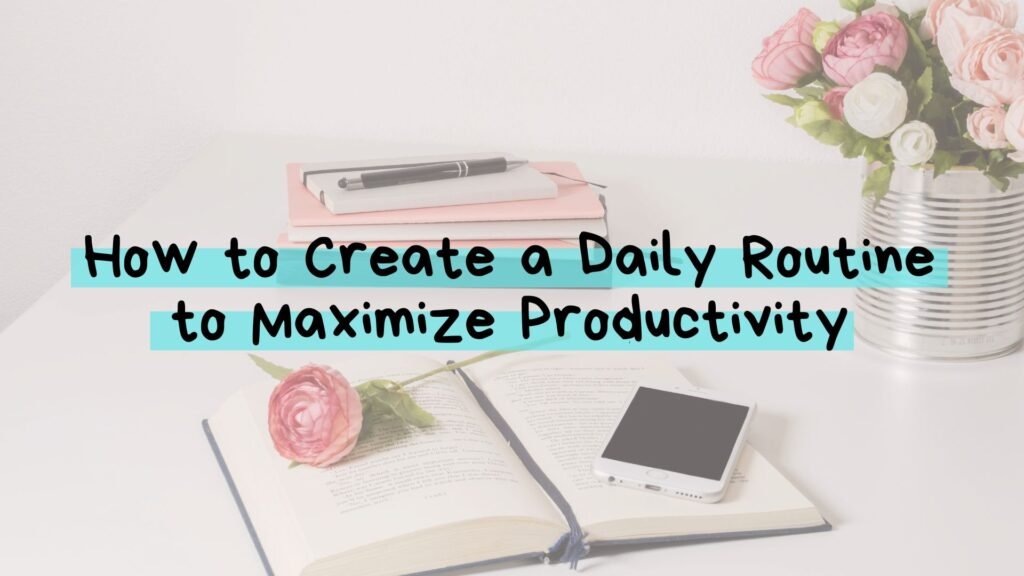We all have 24 hours in a day. But why do some people achieve so much more? And you struggle to finish your daily tasks.
It’s because they follow a well-planned routine.
According to the American Psychological Association, 77% of people experience physical symptoms of stress regularly. However, when you have a routine, it brings a sense of predictability. You feel more in control and less worried.
In this article, we’ll discuss how to make a plan and create a daily routine that works for you.
How to Create a Daily Routine

Assess Your Goals and Priorities
Before planning your day, clarify what you want to achieve and set your priorities.
Ask yourself:
- What would make you feel like a successful day?
- Which tasks do you consistently postpone?
- What activities do you wish you had more time for?
Then, set SMART goals, that fit your needs.
Time Blocking for Maximum Efficiency
Treat your day like 24 pieces. Each hour is a chance to focus on something important.
Think of your day as a puzzle made up of 24 one-hour blocks. Each block is like a part of your day, for work, hanging out with friends, eating, and doing things you enjoy. You have to figure out how to fit everything you need to do into these blocks.
How to make it work?
Identify Your MITs (Most Important Tasks)
- Choose 2-3 most important things (MITs) you need to get done
- Allocate specific time blocks for each MIT
- Do these when you have the most energy (for most people, that’s morning)
Minimize Distractions
- Set up a dedicated workspace
- Use website blockers during focus time
- Keep your phone in another room
Take Mini-Breaks
Working non-stop is tiring. Take regular breaks during your work.
Use Pomodoro Technique: work hard for 25 minutes, then take a 5-minute break.
Establish a Morning Routine
You don’t have to join the 5 AM club, but how you start your day matters a lot.
Here’s a morning routine that actually works:
- Wake up at the same time even on weekends
- Move your body – even a 5-minute stretch counts
- Take a moment to breathe (call it meditation if you want)
- Eat healthy breakfast that’ll keep you going
- Make a to-do list for the day
Manage Digital Distractions
Your phone kills your productivity.
Practical Steps:
- Turn off all non-essential notifications
- Use app timers to limit social media
- Check email and social media at scheduled times only
- Create tech-free zones in your home
Keep the work-life balance

You need a life outside your work. A well-structured daily routine allows you to keep work-life balance.
Make Time for What Matters:
- Schedule time for hobbies in your daily routine
- Set boundaries for work hours
- Plan regular check-ins with friends and family
Make an Evening Routine
Your evening routine sets you up for the next day.
Look Back at Your Day
- What worked?
- What didn’t?
- What could you do better tomorrow?
Plan for Tomorrow
- Take 10 minutes to set out what you need
- Write down tomorrow’s MITs
- Check your schedule
Think Big
Where do you want to be in a year? Five years? Dream big, then break it down into daily steps.
Work everyday on something that moves you closer to your larger goals.
Create Your Personal Routine
Analyze your life goals and make your routine that suits best to you.
- Figure Out What’s Important: Note down the important stuff, like work, health, friends, and hobbies.
- Decide What You Want: Set goals in these areas. For example, exercise regularly or more time with loved ones.
- Make a To-Do List: Break your goals into smaller tasks.
- Decide When to Do Things: Utilize your top energy hours for productive work.
- Make a Schedule: Assign time for each task and stick to it.
- Give Yourself Extra Time: Plan for things to take longer than you think.
- Do the Most Important Stuff First: Put the tasks that matter most at the beginning of your day.
- Do Some Things Every Day: Repeat your tasks at the same time to make a habit.
- Check How You’re Doing: Take a look at your routine regularly to see if it’s working for you.
- Stick to Your Plan: Try your best to follow your schedule, even when you don’t feel like it.
- Take Breaks: Give yourself some downtime during the day to relax and recharge.
- Keep at It: Stay consistent with your routine, even on weekends or days off.
Benefits of a Well-Planned Routine
- Get more done without burning yourself out
- Reduced stress and anxiety
- Find time for things you actually enjoy
- Sleep better
Final Thoughts
Making a daily routine is tough, but it’s worth it for all the benefits. You’ll get more done, your mornings will be calmer, and you’ll have more free time.
Your routine is a useful tool. It keeps you focused, lowers stress, and manages your time. The best part? It can change and grow with you.
FAQs
What foods should I include in my daily routine to boost productivity?
Add foods that boost your brain like blueberries, fatty fish, nuts, and seeds to your meals. Drink plenty of water.
How do I maintain my motivation to stick to a routine?
Stay motivated by tracking your progress. Give yourself rewards when you reach goals. Get support from friends or a mentor.
What is the best time to wake up for maximum productivity?
Waking up early, as the “5 AM Club” suggests, gives you quiet time for personal growth and getting things done. But the best wake-up time depends on what works best for you.
What are the recommended tools or apps for managing daily routines?
There are many time management apps, such as Trello, Todoist, and Forest. They help you plan and track your daily tasks more effectively.








Pingback: 7 Daily Habits That Transform Your Life and Bring Success | goalsempire.com
I have shared this post with my colleagues, it’s too good to keep to myself.